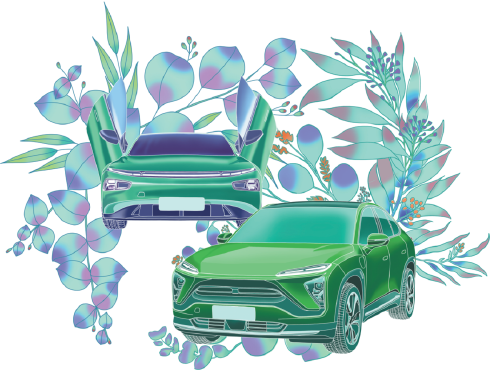Fully charged
As the race to electrification heats up, China should not squander the leading position it is in now
The transportation sector accounts for approximately one-fourth of global anthropogenic carbon dioxide emissions. A faster transition to zero tail-pipe emissions vehicles is critical to putting the global transportation sector on a trajectory that aligns with the Paris Climate Agreement goals. Around the world, policies and regulations are being implemented with varying degrees of intensity and consumer attitudes are shifting. As the global transition to electric vehicles accelerates, manufacturers must shift gears quickly to remain relevant.
In 2022, China's share of electric vehicles in new light-duty vehicle sales — which include cars, vans and light commercial vehicles — reached 24 percent.
Of the three largest vehicle markets in the world, China is leading in electric vehicles share compared with 21 percent of Europe and 7 percent of the United States based on the 2022 International Council on Clean Transportation (ICCT) electric vehicle market monitor.
In addition, China also has the world's largest electric vehicle charging network. This fast electric vehicle development reflects China's successful policies such as the NEV mandate, subsidies, industry strategies and plans, and other local-level policies over the past decade to drive technological advances.
The ICCT has recently released a Global Automaker Rating 2022 report that rates how the world's 20 largest vehicle manufacturers are doing in the transition to electric vehicles and found that the largest Chinese automakers are at different stages compared with other global vehicle giants, with scores ranging from 36 to 73 out of 100. While it is not surprising to find Tesla at the top of the new rating with a score of 83 out of 100, Chinese manufacturer BYD is close behind with a score of 73. BYD is also the only legacy automaker to have gone all-electric and earned high marks for the range of vehicle classes on offer, its battery recycling efforts and leadership in strategic vision. Tesla and BYD are the only two manufacturers with scores high enough to earn the label of leader.
Additional Chinese manufacturers included in the report were SAIC, Geely, Chang'an, and Great Wall, all of which scored less than 50 (out of 100) and were included in the category of transitioners. Perhaps because China as a major market leads the world based on both EV sales shares and by volume, according to the ICCT, SAIC, Geely and Chang'an were ahead of most for the zero-emission vehicle-equivalent sales share.
Chinese manufacturers also performed well in the zero-emission vehicle class coverage and battery recycling metrics. SAIC offers electric vehicles in every class considered, while Chang'an, Geely and Great Wall sell vehicles across passenger and light commercial vehicle segments. Their resulting coverage rates are between 75 percent and 88 percent.
While more than half of the manufacturers considered earned leadership marks for efforts in battery recycling or repurposing, Geely, BYD and Great Wall received 100 points for their efforts.
Still, the transition to zero-emission vehicles is complex, requiring innovation and new thinking from the supply chain to the driver's experience. Every automaker has work to do in order to capture this growing market. Although the Chinese manufacturers are far ahead in the electric vehicle sales share, there is significant room for improvement if the goal is global leadership.
Utilizing renewable energy for production is still something that most Chinese manufacturers are struggling to do well. In 2022, Great Wall, BYD and Chang'an reported generating approximately 71 GWh, 44 GWh and 37 GWh of electricity, respectively, from solar power. However, these amounts are a small fraction of the total electricity used by these manufacturers, and stronger policies at a national level will be needed to accelerate and support the upstream decarbonization of manufacturers and help the country to meet the "dual carbon "goals of peaking carbon dioxide emissions before 2030 and achieving carbon neutrality before 2060.
Although China became the world's largest vehicle exporter in the first quarter of 2023, the proportion of electric vehicle exports remained low. Increasing electric vehicle exports could be a crucial milestone for China to compete in a global car market that is rapidly transitioning to zero-emissions vehicles. However, before that, manufacturers need to create cars that appeal to a wider range of consumers.
SAIC and Chang'an received low ratings in zero-emissions vehicles performance, especially in charging speed and driving range. These manufacturers sell large volumes of less expensive battery electric vehicles that are aimed at urban dwellers to meet daily commuting needs. In fact, all Chinese automakers evaluated fall short on zero-emissions vehicles performance metrics, and will need to improve to be desirable at a global scale.
In 2022, China succeeded in jumping ahead of Europe on the two key metrics of absolute zero-emissions vehicles sales and the zero-emissions vehicles sales share, while simultaneously growing its lead over the US. But the world is waking up to the opportunity at stake for an accelerated transition to electric vehicles. In the end, the nation to emerge as the leader has a lot to gain, and China should not squander the position it is in now.

Yang Zifei is the lead for the global passenger vehicle program. Kelli Pennington is the communications manager at the International Council on Clean Transportation. The authors contributed this article to China Watch, a think tank powered by China Daily.














